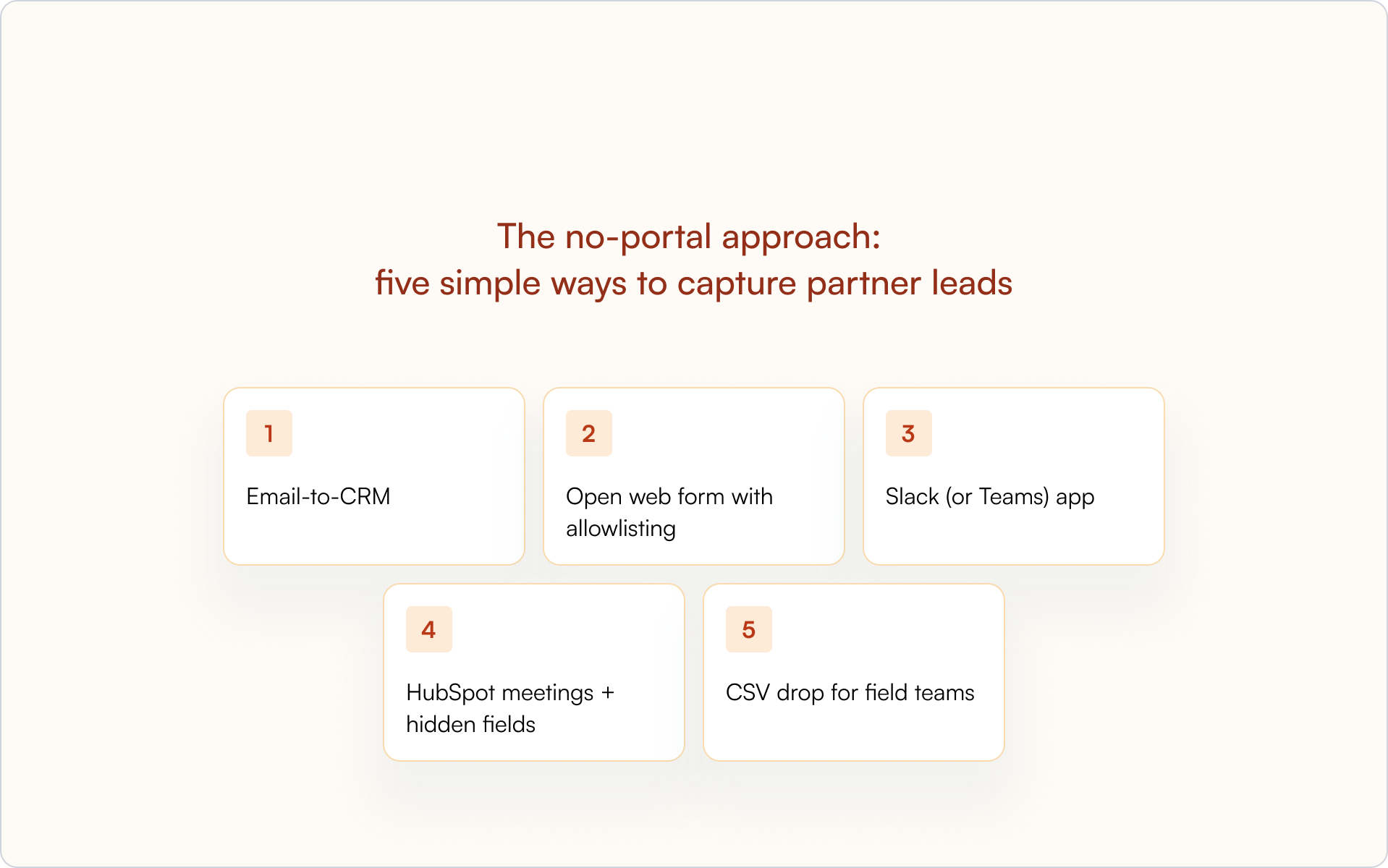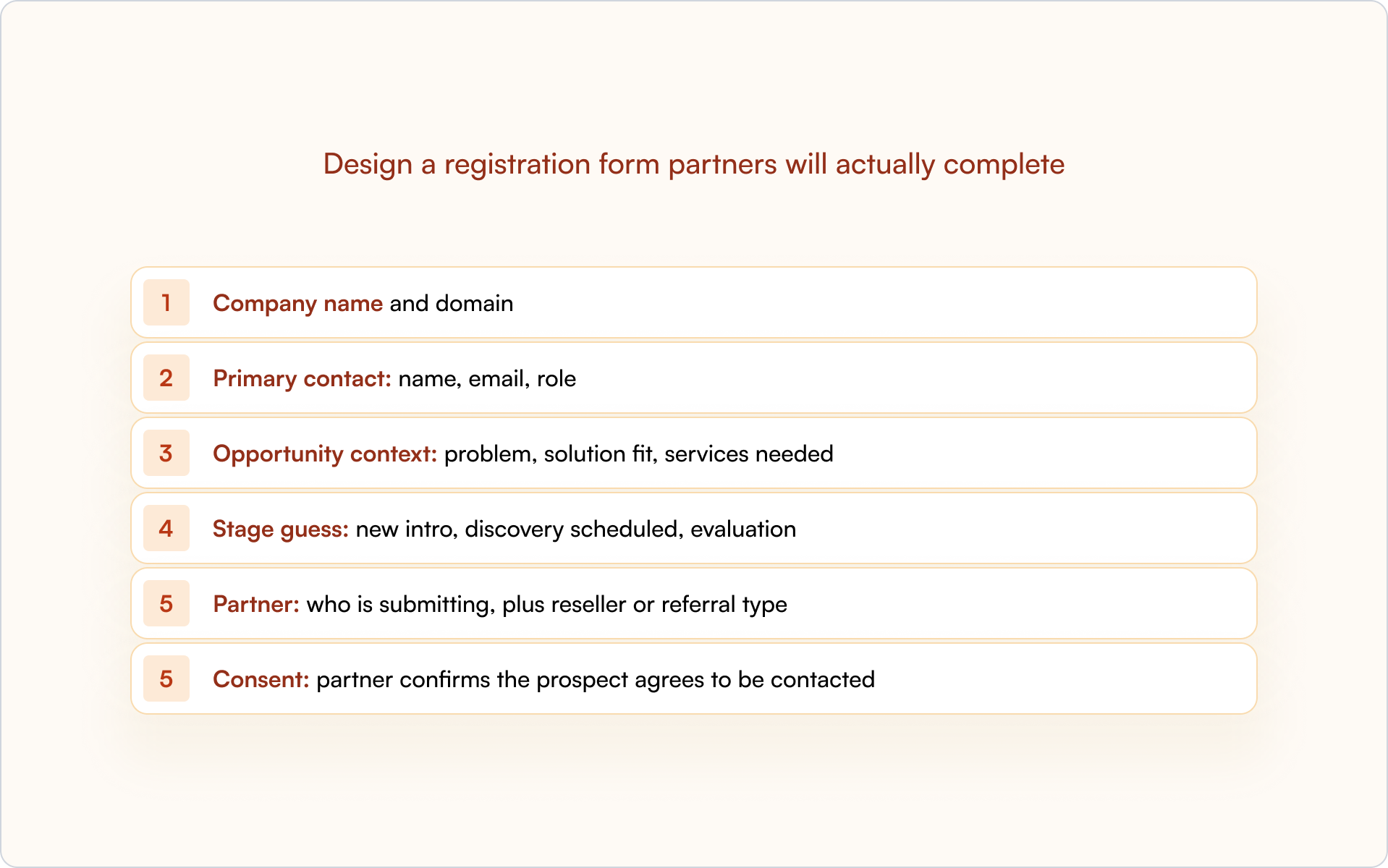Channel management isn’t about working harder — it’s about managing smarter. Whether you're scaling across indirect sales channels, empowering your channel partners, or optimizing your partner network, the right strategy makes all the difference.
A strong channel management strategy helps you align your business objectives with the partners that can move your product, expand your reach, and grow your bottom line. But without clarity and consistency, you’ll run into channel conflict, poor visibility, and disengaged partners — all of which stall growth.
This guide outlines 10 proven best practices to help you elevate your channel management efforts, improve partner performance, and build a more efficient, scalable revenue engine.
From setting clear goals and automating workflows to improving communication and analyzing channel performance, these strategies are designed for channel managers ready to win in today’s complex, multi-partner landscape.
What is Channel Management?
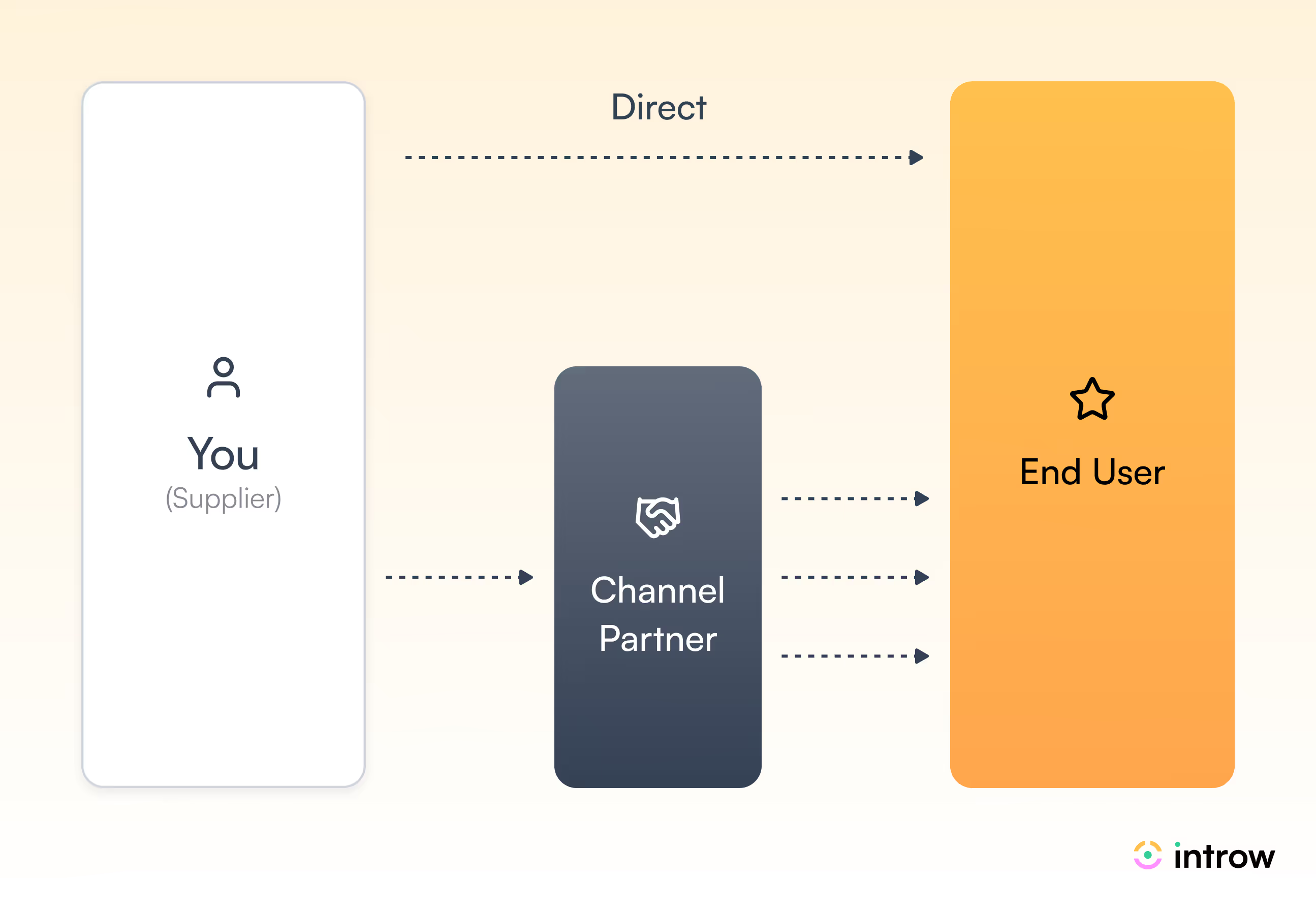
Before you can optimize your partner strategy, you need a clear understanding of what channel management really means — and why it’s essential for sustainable business growth.
Most companies rely on a mix of direct sales and indirect sales channels to reach their target customers. But as your business scales, juggling multiple sales channels without a clear system creates confusion, misalignment, and missed revenue.
That’s where effective channel management comes in — the foundation for building, maintaining, and scaling strong partner relationships.
Let’s break it down.
A channel is more than just a system — it’s your gateway to delivering products and services to the end customer.
Going through direct channels means your sales team handles every touchpoint: prospecting, selling, servicing, and supporting. It’s personal — but hard to scale.
By contrast, channel partners — like resellers, distributors, affiliates, and even e-commerce platforms — extend your reach through distribution channels you couldn’t access alone.
Think of it like this: Instead of selling toothpaste tube by tube, you sell an entire pallet to a retailer who handles the rest. In the SaaS world, channel partners introduce your product into networks and customer segments you haven’t penetrated yet.
Channel management refers to the systems and processes you use for managing relationships with the partners who sell, support, or promote your offering to the market.
A solid channel management strategy ensures these relationships are aligned with your business goals, supported with the right tools and training, and optimized for long-term performance. In short: it’s the blueprint for scalable, profitable growth through partners.
Common Challenges in Channel Management
Even the most promising channel strategy can fall short without a solid foundation. Many companies enter partnerships with the best intentions, only to find themselves facing roadblocks that stall channel performance and hurt business growth.
Whether you're just starting out or managing a mature partner network, it’s critical to understand the most common friction points and how they impact your results.
Here are four challenges that often derail effective channel management:
1. Lack of Alignment
A SaaS company partners with resellers but doesn’t align on sales targets or target customer profiles. The result? Conflicting priorities, overlapping efforts, and missed revenue opportunities.
2. Inconsistent Communication
A SaaS provider launches a major product update but only notifies a few partners. Others remain in the dark, unable to update marketing materials or support end customers, causing confusion and delays.
3. Poor Feedback Loop
New features are rolled out, but partner feedback is never collected. Valuable frontline insights are lost, resulting in lower adoption and features that don’t resonate with users.
4. Inadequate Training
Partners are onboarded quickly but without proper enablement. Without a clear understanding of the product, value props, and sales tools, they struggle to convert leads and support customers.
Each of these issues stems from one core problem: poor relationship management. And the impact is real — misalignment, inefficiencies, and channel conflict that erodes trust and slows momentum.
The good news? Every one of these challenges is fixable.
The right channel management tools can eliminate inefficiencies, increase partner performance, and ensure your channel management efforts are aligned with your most important business objectives.
Tools like Introw give you full visibility into your partner ecosystem — from onboarding to enablement to deal tracking. By reducing knowledge gaps and increasing accountability, you empower partners to succeed and scale faster.
So how do you move from reactive to strategic?
You start by optimizing every stage of the channel management process — from recruitment to retention.
In the next section, we’ll break down the 10 best practices that define a high-performance channel management strategy.
Optimize Every Stage of Channel Management with Modern PRM Tools
Mastering channel management means taking a lifecycle approach to your partner program — from recruitment and onboarding to co-selling and expansion. Each phase plays a critical role in achieving alignment, improving partner performance, and scaling revenue.
Modern channel management software like Introw enables this end-to-end orchestration. With seamless CRM integration, real-time deal tracking, and partner-friendly collaboration tools, you can support your entire partner network without friction.
Unlike outdated tools or spreadsheets, Introw aligns your channel managers, direct sales team, and indirect sales channels under one unified platform — so you can analyze channel performance, manage distribution partners, and grow revenue faster.
Let’s walk through the 10 key practices that define a high-performing channel management strategy, and how tools like Introw help you implement them across multiple sales channels:
1. Define Clear Channel Goals
If you want your channel programs to thrive, clarity is non-negotiable. Your channel partners need to understand exactly what you aim to achieve from the collaboration — and you should be clear on the value you’re delivering in return.
To execute a successful channel, start with measurable objectives tied to your business goals — such as growing a specific customer segment, launching in a new market, or improving customer satisfaction.
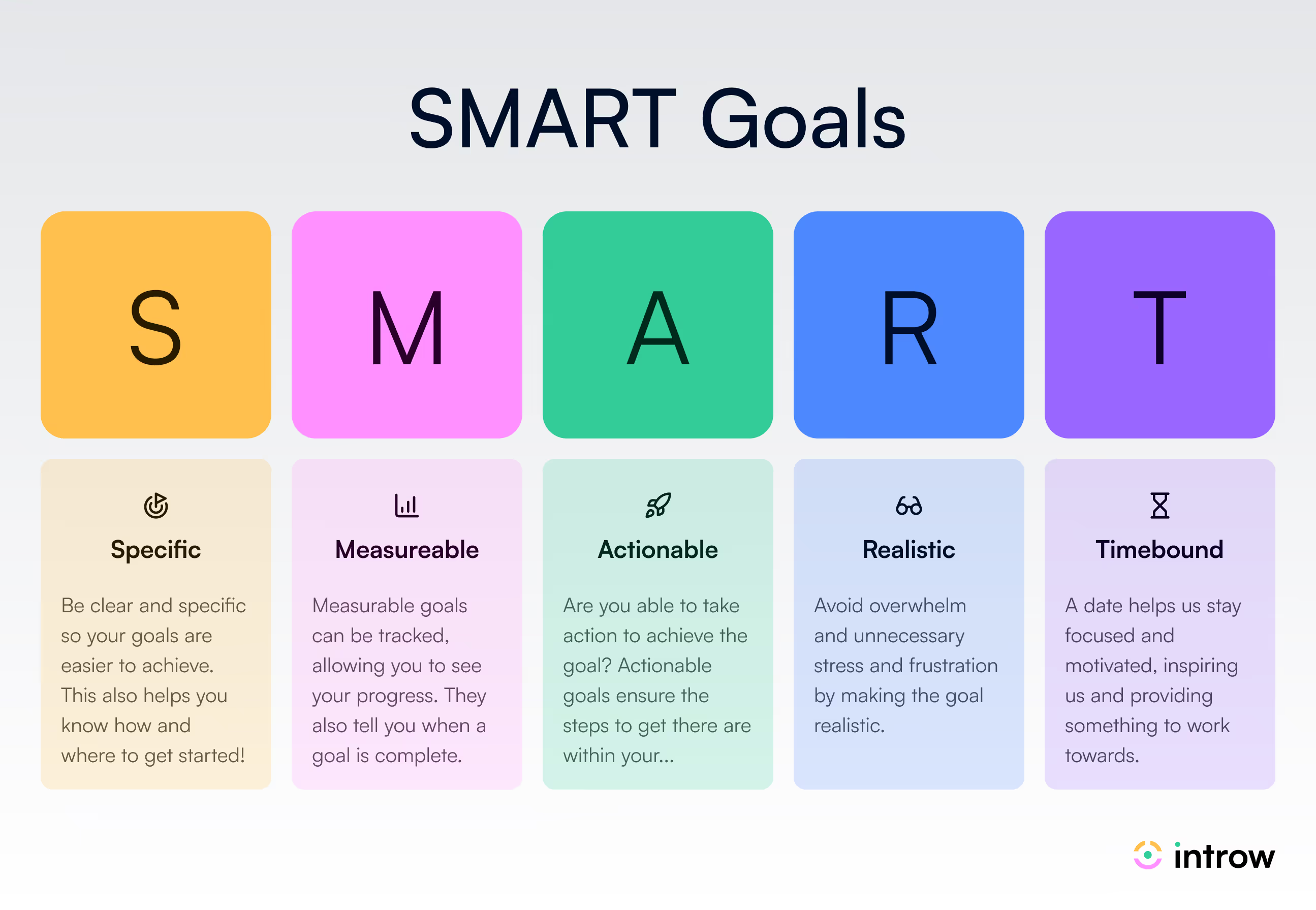
That’s where PRM platforms like Introw come in.
Introw transforms SMART goals into trackable metrics — like referral rates, sales process efficiency, and campaign impact — and visualizes them in real-time dashboards. This makes it easy for channel managers to track progress and optimize faster.
With automated KPIs and clear visibility, your channel strategy stays aligned across teams and partners.
2. Choose the Right Partners
When it comes to building a high-performance partner network, quality always beats quantity.
Too many companies take a "more is better" approach, signing dozens of channel partners without clear alignment. The result? Mixed priorities, missed revenue, and constant channel conflict.
Instead, focus your channel management efforts on a select group of high-impact partners:
- Partners who align with your business objectives and target customers
- Organizations that bring complementary reach, technology, or expertise
- Teams that can scale alongside your growth in multiple channels
Introw helps channel managers identify these high-potential fits through partner profiling, CRM overlap analysis, and visibility into historical engagement.
Pro tip: Use Introw’s native Crossbeam integration to discover partner overlaps, shared accounts, and warm intro paths — so you invest in partners that can actually move the needle.
And don’t forget to evaluate:
- Willingness to Invest: Are they engaged in joint planning, marketing strategy, or co-selling?
- Ability to Scale: Can they grow with you across new markets and distribution channels?
- Complementary Strengths: Do they unlock access to underserved customer segments or fill a technical gap?
A partner with a proven track record, strong internal enablement, and enthusiasm for collaboration is more valuable than ten who just want portal access.
3. Invest in Partner Onboarding
Initial onboarding isn’t just a checklist — it’s the foundation for long-term partner relationships and sales growth.
When channel management involves proper onboarding, partners:
- Understand your product positioning
- Get trained on your sales tools and ICP
- Learn how to represent your brand effectively in-market
Introw’s partner onboarding tools eliminate manual overhead with:
- Streamlined approval flows and digital agreements
- Auto-triggered welcome sequences and training checklists
- CRM-integrated training progress tracking
Your channel management software should reduce time-to-productivity and drive early wins.
With Introw, you can:
- Deliver custom content per partner tier or type
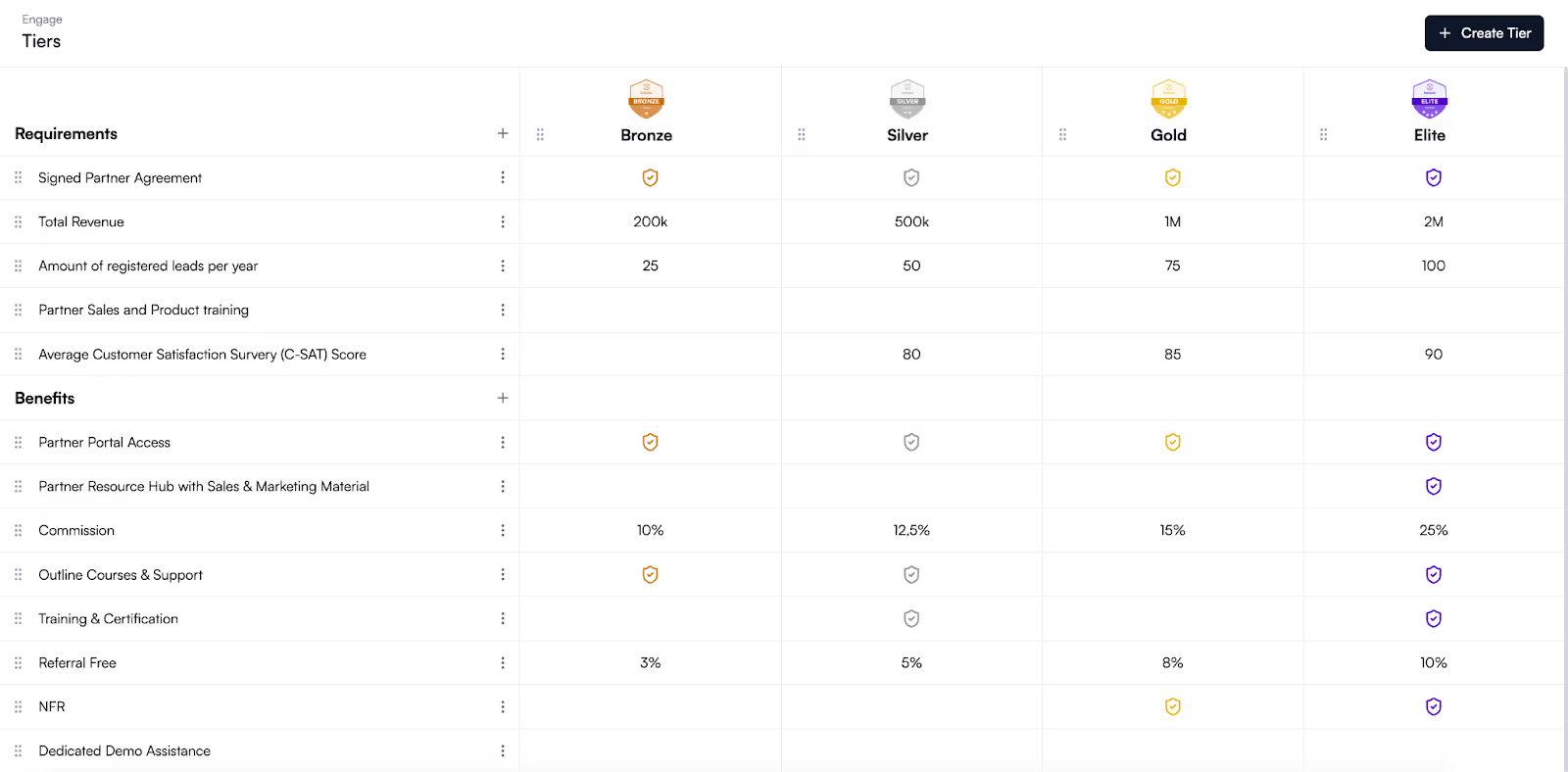
- Issue certifications for completed courses
- Track onboarding completion right from your CRM system
Because effective channel management ensures every partner gets the support they need — without overloading your internal teams.
4. Master Channel Management with a PRM Tool
Once your onboarding foundation is in place, the next step is to unify your ecosystem. That’s where a purpose-built PRM tool becomes essential to every aspect of your channel management strategy.
While traditional systems struggle to connect your sales channels, partner relationships, and real-time metrics, a modern solution like Introw brings them all together in one interface.
With Introw, you:
- Eliminate data silos across CRM systems, spreadsheets, and email threads
- Track deals, accounts, and partner activity in one place
- Enable cross-functional visibility between your direct sales channels and indirect sales teams
Introw’s CRM-native approach means you don’t have to switch tabs or train partners on new software. Instead, you get a lightweight experience that works through tools your teams already use — like Slack, Gmail, Salesforce, and HubSpot.
This integration enables:
- Real-time alerts when a deal is touched
- Shared dashboards to monitor channel performance
- Actionable insights for analyzing channel performance and resolving gaps
By giving both internal teams and channel partners access to centralized, real-time data, you reduce friction, improve accountability, and enable a more consistent customer experience.
Introw isn’t just the right tool — it’s the right channel management software for modern B2B teams who want faster execution, smarter collaboration, and measurable sales growth.
Let’s now explore how automation helps scale those results even further — while eliminating one of the biggest pain points: channel conflict.
5. Automate Manual Processes to Prevent Channel Conflict
Even the most aligned partner ecosystems face operational friction. Manual processes — like deal registration, email follow-ups, or lead assignment — often lead to miscommunication, duplication, and channel conflict.
Without automation, channel managers waste hours chasing updates or resolving disputes between distribution partners. And worse — deals fall through the cracks.
Introw automates the complexity so your team can stay focused on driving results. Here’s how:
- Deal Registration Automation: Prevent duplicate entries by flagging overlaps in real time across your CRM systems.
- Auto-Synced Workflows: Trigger follow-ups, assign tasks, or escalate conflicts automatically — no manual coordination required.
- Real-Time Notifications: Notify sales reps or channel partners immediately when a deal progresses or a task is completed.
By streamlining these core workflows, you reduce errors, improve sales performance, and maintain trust across your partner network.
6. Enhance Partner Communication
Strong partner relationships are built on clear, consistent communication. But too often, partner comms are scattered across emails, Slack messages, and outdated dashboards.
A unified system — like Introw — brings it all together.
With Introw, you can:
- Sync messaging across your CRM system, Slack, and email
- Share updates on campaigns, product changes, or marketing materials in real time
- Create account-specific channels for seamless collaboration between internal and external teams
This centralized visibility keeps your sales channels aligned and your channel strategy moving forward.
Plus, with integrated customer data and deal timelines, your channel partners never miss a beat — and your end customers get a smoother, more informed buying experience.
7. Create Regular Training Programs
Great partners aren’t found — they’re developed. Ongoing enablement is a critical pillar of effective channel management.
Whether you’re onboarding new MSPs, resellers, or VARs, your training should cover:
- Product updates and positioning
- Competitive landscape and market trends
- Use cases by customer segment and industry
- Sales tactics, pricing strategies, and objection handling
With Introw:
- Launch and manage certification programs by partner tier
- Track completion through embedded quizzes and progress dashboards
- Deliver content in multiple formats — PDFs, videos, Google Docs — all within one branded partner portal
This keeps your channel programs scalable and your partner performance consistent across various sales channels.
8. Incentivize and Reward High Performance
Nothing accelerates channel sales like the right incentives. And nothing derails it faster than unclear or delayed payouts.
High-performing channel partners want transparency and trust — and channel managers need a scalable system to track it all.
With Introw:
- Set up tiered commission structures or SPIFs
- Track revenue attribution by partner, territory, or campaign
- Automate payout reporting and eligibility reminders
You can even integrate partner performance data with your CRM system or finance tool to eliminate manual calculations and ensure every reward is backed by real-time numbers.
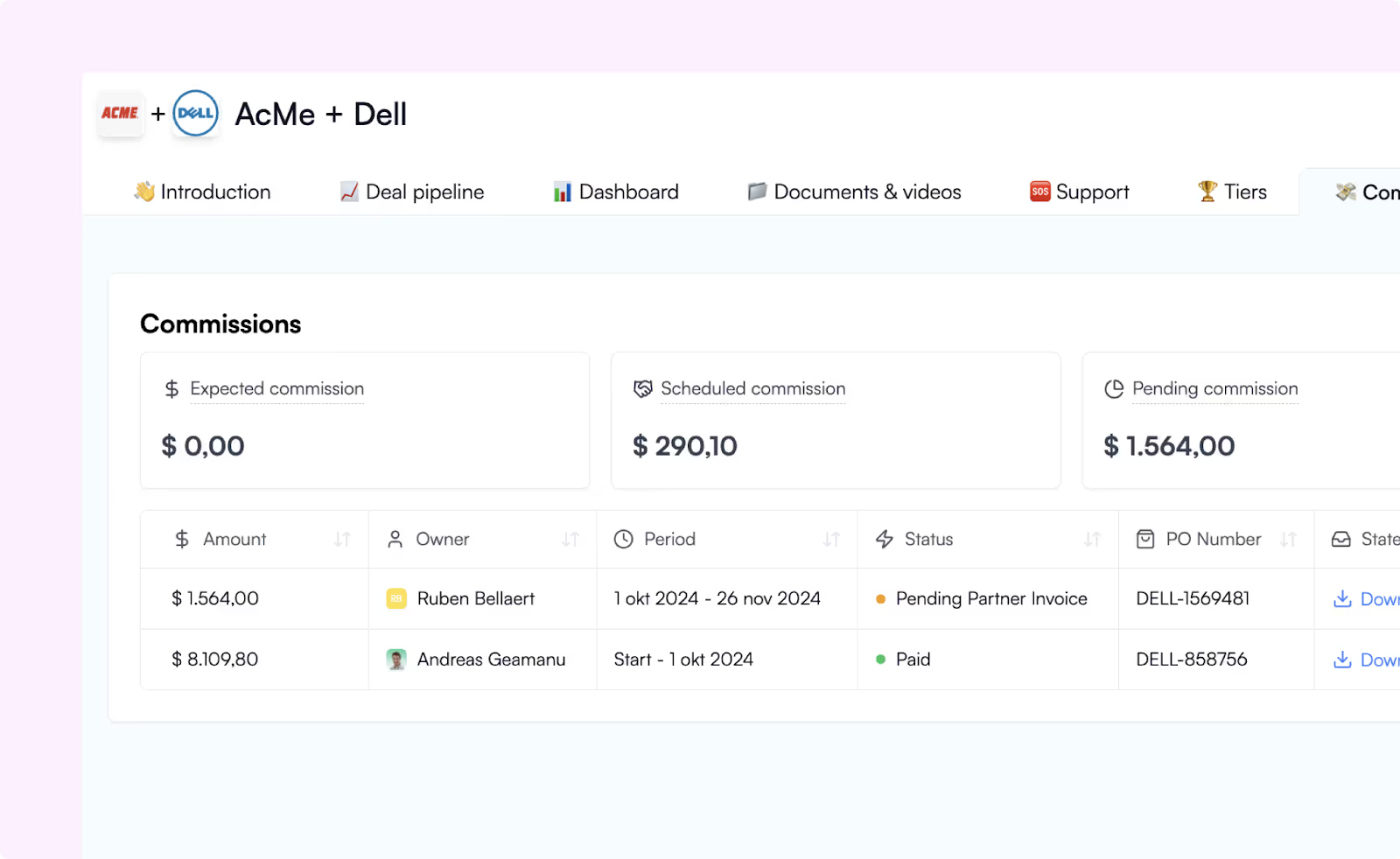
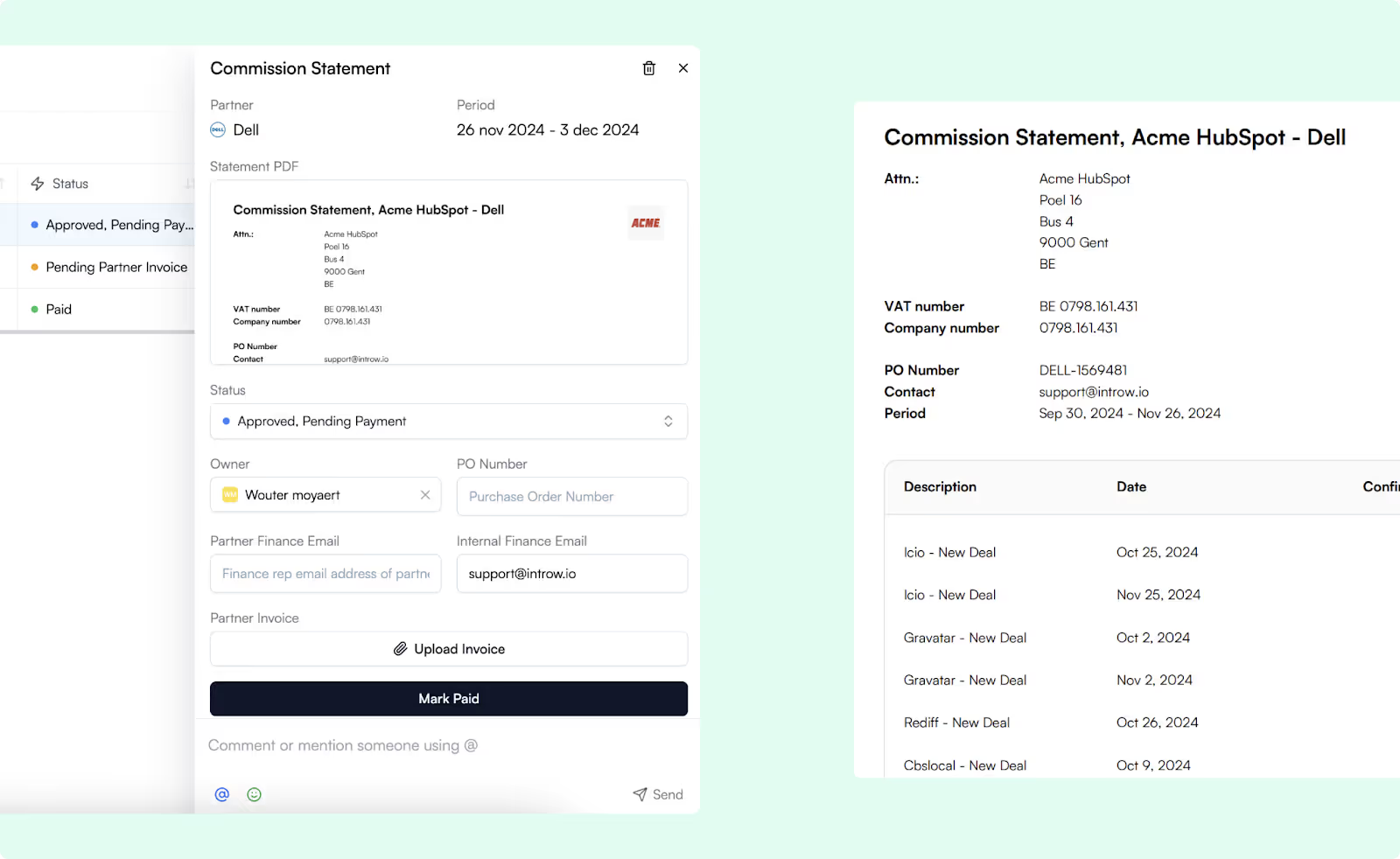
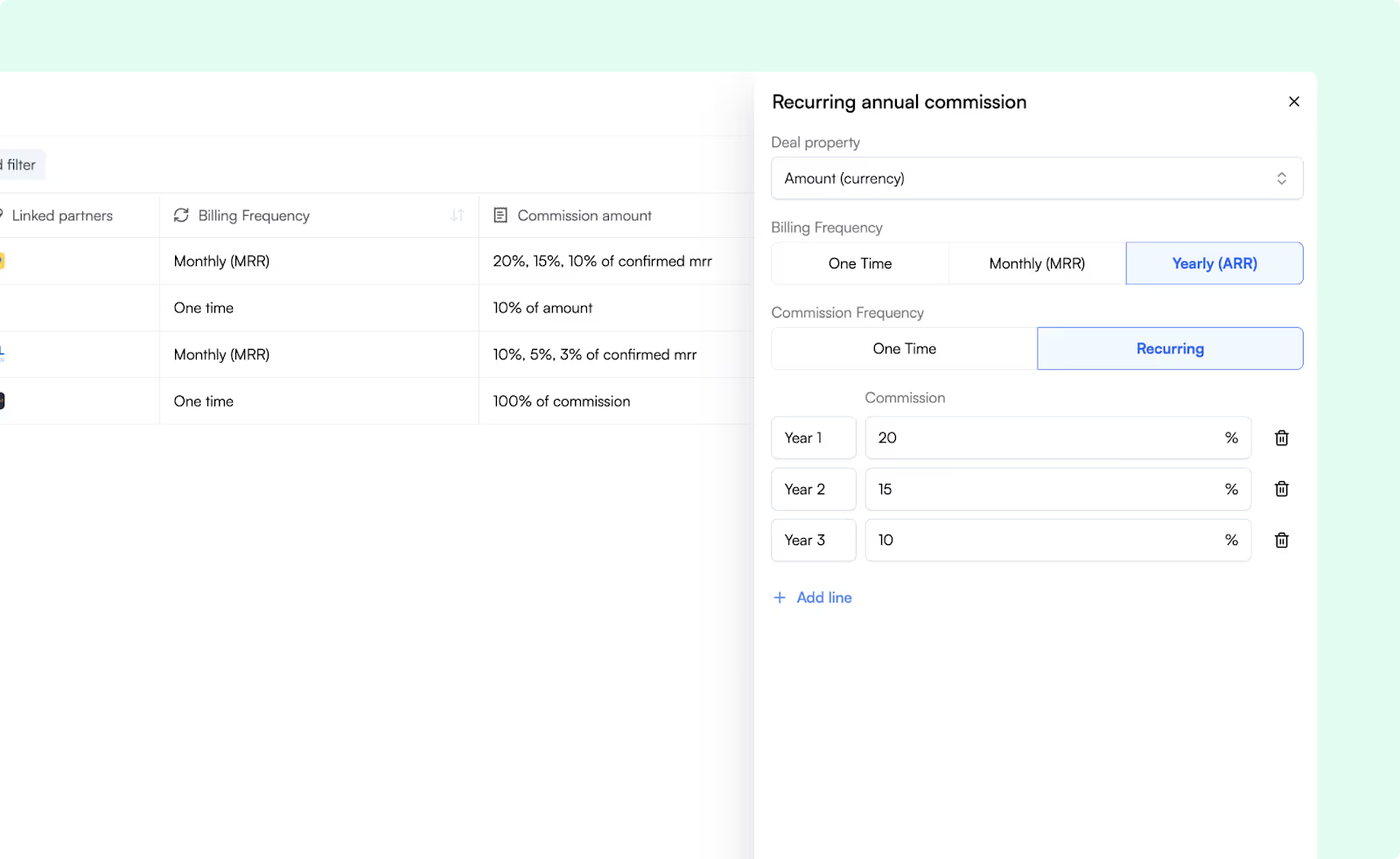
This keeps motivation high, reduces disputes, and turns your partner program into a powerful sales engine.
9. Monitor Performance and Deliver Feedback
To continuously improve your channel management strategy, you need visibility. Not just into revenue — but into deal velocity, campaign engagement, and partner health.
Introw’s reporting engine makes it easy to:
- Set key performance indicators (KPIs) by partner type
- Analyze contribution to pipeline and close rate
- Identify underperforming regions or partners at risk
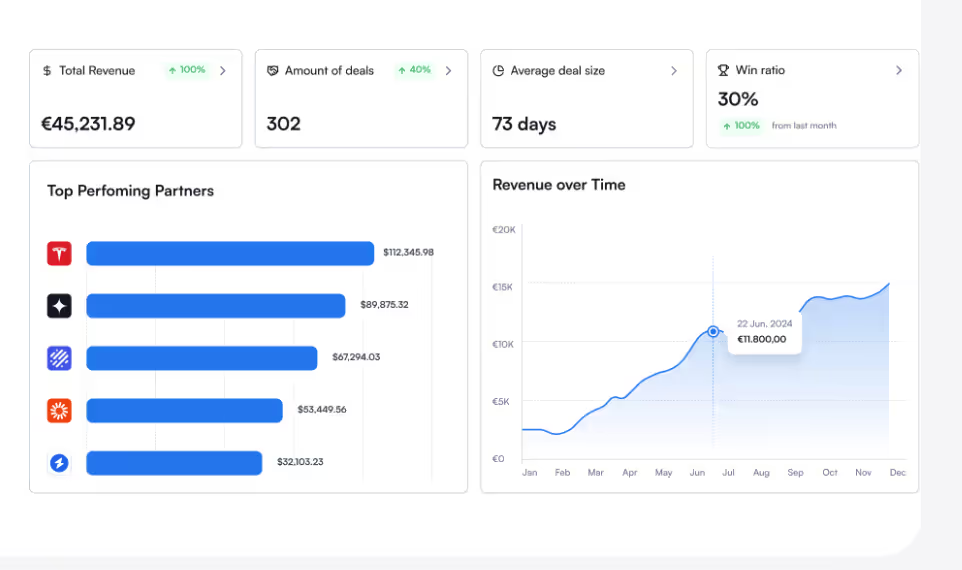
More importantly, it enables ongoing support — through automated feedback loops, QBRs, and personalized coaching plans.
Because channel management involves more than just metrics — it’s about managing relationships that fuel long-term business growth.
10. Amplify Success Through Channel Marketing and Co-Marketing
Finally, even the best partnerships can stall without marketing support. Your partners need assets, guidance, and budget to drive demand — and you need visibility into what’s working.
A modern channel campaign management approach includes:
- Co-branded email and ad templates
- Social content tailored to customer preferences
- Campaign tracking tied to lead generation or revenue
With Introw:
- Share approved messaging and assets in your partner portal
- Track campaign adoption and outcomes by region or partner
- Collect insights that help you optimize your marketing strategy across the ecosystem
Co-marketing isn’t a nice-to-have — it’s a growth multiplier. With Introw, you can turn co-marketing from ad hoc to always-on.
Conclusion
Without effective channel management, even the best partner programs stall. If your strategy isn’t aligned, automated, and data-driven — you’re leaving revenue on the table.
A modern channel management strategy requires clear goals, the right partners, a frictionless onboarding experience, and consistent training and communication. But most importantly, it needs a system that scales.
That’s where Introw comes in.
With Introw, channel managers can:
- Eliminate manual workflows and reduce channel conflict
- Improve visibility across multiple sales channels and partner types
- Automate onboarding, training, deal tracking, and performance reporting
- Support better partner relationships with real-time CRM insights
- Track and analyze channel performance and drive revenue growth
Whether you’re running a mature channel sales strategy or just starting to scale with indirect sales channels, Introw gives you the right channel management software to move faster, stay aligned, and grow with confidence.
Ready to turn your partner ecosystem into a high-performing revenue machine?
Why is channel management important for SaaS companies?
Channel management ensures your partner ecosystem aligns with your business goals. It helps you scale beyond direct sales by leveraging indirect sales channels to reach new customer segments and increase revenue with less overhead.
How does channel management software support partner relationships?
Channel management software, like Introw, automates and centralizes key tasks such as onboarding, deal tracking, and co-marketing. This improves transparency, streamlines collaboration, and strengthens partner engagement across your network.
What metrics are used to analyze channel performance?
You should track KPIs such as deal velocity, revenue contribution by partner, training completion, and campaign engagement. Analyzing channel performance helps you identify high-impact partners and optimize your channel strategy.
How do I choose the right channel management software?
The best channel management tools integrate seamlessly with your CRM systems, support customizable workflows, and offer real-time visibility into sales activities, partner performance, and customer feedback — all of which Introw delivers out of the box.
How can channel managers align partners with the company’s target market?
Start by clearly defining your ideal customer profile and target market. Then, use tools like Introw to map your partners’ capabilities, customer base, and vertical expertise. This ensures every partner effort is directed at the right audience for maximum impact.


.svg)

























